 Indexed data from more than ten million records from the state of New York for the years 1880-2017 have now been ordered released by the New York Court of Appeals, the highest court in New York.
Indexed data from more than ten million records from the state of New York for the years 1880-2017 have now been ordered released by the New York Court of Appeals, the highest court in New York.
The court has also remanded the parties back to a lower court so that a judge may conduct an “in-camera review” of which additional fields of data for all years may potentially also be disclosed by the state, with the presumption being that most data contained in death indices should be open to the public. The data will be freely published here once the state eventually turns over the finalized public data set to Reclaim The Records, as ordered.
Reclaim The Records, a non-profit organization dedicated to government transparency and public access to historical records, proudly announces the court-ordered release of information from millions of New York State death records, spanning three centuries of New York’s vibrant history. Last week, after a four-year legal battle, New York State’s highest court, the Court of Appeals, ruled in favor of Reclaim the Records in the case Matter of Reclaim the Records v. New York State Department of Health, finding that the Department of Health must disclose comprehensive death index records that had been requested under the state’s Freedom of Information Law (FOIL).
This decision mandates the release of detailed information about more than ten million deceased New Yorkers, including their names, dates of death, residences at death, ages at death, and associated state file numbers, for all years spanning from the start of state-mandated records collection in 1880 through the end of the year 2017, extending far beyond the limited online database for state deaths from 1957 to 1972. The court has also suggested that many more fields of data than just the ones previously available for the limited timeframe may also be disclosed under FOIL, and has ordered the state to provide its records for an in-camera review to determine which additional fields of data may be released under FOIL, with the presumption clearly being stated as the public’s right of access to most of the information.
Brooke Schreier Ganz, founder and president of Reclaim the Records, stated:
Reclaim The Records began our work ten years ago right here in New York, using Freedom of Information laws as a direct reaction to the state’s unusually restrictive access to government-held historical and genealogical materials. All of New York’s neighboring states, and many others across the country, have made this same kind of vital records index information freely available to the public over the years, and finally those of us who live in the state or who have deep roots in the state will get to enjoy the same kind of access for our own families and research projects. With this lawsuit win, historians, genealogists, journalists, and teachers will be able to freely access state information about the millions of people who lived in, and died in, the Empire State.
She continued:
Beyond the particular records being released in this case, we are also gratified to have the Court of Appeals uphold so many important parts of New York’s Freedom of Information Law, and to reiterate the right of public access to government-held materials, even in the face of agencies who attempted to keep them secret without legal justification. Public records belong to the public, and we are thrilled to know this case will help many other people and organizations use the state FOIL to reclaim their own records, for many years to come.
Ganz added that the non-profit intends to publish this historical and modern death index data for free public use, in searchable, downloadable, and reusable file formats, as they have done after similar lawsuit wins in other states and jurisdictions.
Alec Ferretti, Professional Genealogist and Reclaim the Records Director explains:
The Court has affirmed the public’s right to its own history. Millions of deceased New Yorkers’ basic biographical information, previously entombed in a decommissioned Albany bomb shelter, will finally become accessible to all. Reclaiming the New York State Death Index will put New York in line with all its neighboring states, help clear the Department of Health’s research backlog, deter fraud, and pave the way for legislation that opens up even more historic records.
Alex Calzareth, Professional Genealogist and Reclaim the Records Director continues:
New Yorkers and their families will now have much easier access to their history. The New York State death index will help family historians and journalists among others to recover stories that have faded over time. This decision is a win for transparency and puts an authoritative and comprehensive source of government information in the public’s hands.
Michael Moritz, the organization’s attorney on the case, added:
After four years of representing RTR in this matter, from the initial inception of the FOIL request through the administrative process and up to the highest court in the state, I’m ecstatic by the result handed down by the Court of Appeals. This is a great day for RTR and all freedom of information law enthusiasts. I’m very happy that people near and far will be able to benefit from the broader access to New York death index data secured by this case.
The case originated in 2021 when Reclaim the Records filed a FOIL request seeking the full New York State death index through 2017. After the Department of Health denied the request, the organization pursued legal action, culminating in this ruling. This decision not only facilitates greater access to vital records for research and personal purposes but tells agencies in New York State that they need to produce evidence of a harm if they are going to withhold records. Reclaim The Records remains committed to uncovering and releasing public records that have been improperly withheld, ensuring that history remains accessible to all.
Reclaim The Records is a nonprofit organization comprised of genealogists, historians, researchers, and open government advocates. The organization identifies important genealogical record sets that are unjustly restricted by government agencies and works to make them publicly accessible through FOIL requests and, when necessary, litigation.
And now for the nitty-gritty details
Back in 2021, we submitted a Freedom of Information Law (FOIL) request to the New York State Department of Health (NYS DOH), asking them for copies of nearly all of the state’s extant death index records, covering all years from the start of state-mandated records collection in 1880 through the end of the year 2017. After asking the DOH politely, we were told no – twice.
So we sued them, because obviously. And after nearly four years of work, three rounds of brief-writing and expert affidavits, two appeals to two different courts, and plenty of bureaucratic foot‑dragging, we finally heard the good news. In May 2025, New York’s highest court, the Court of Appeals, finally said the magic words we’d been waiting for:
Hand. Over. The. Files. To. The. Public.
You guys…? We won. We won big. 🙂
New York is finally going to have a full state death index available for the public, for free, like all of its neighboring states and many others around the country. Everyone from journalists to teachers to historians to — yeah yeah — genealogists is going to get to use it, finally!
The New York State Court of Appeals has ruled that even though certified copies of state death certificates may have long embargo periods and tough criteria for potentially-entitled parties to request them, the death index data fields that were extracted from those certificates, with some very limited exceptions, are not exempt from disclosure under the state Freedom of Information law. The data is largely not “too private” to be released to the public, nor to go online. The data’s release will also not enable identity theft and fraud against dead people (um, how would that even work…?), despite the state’s unsupported claims to the contrary throughout our lawsuit. And in fact, the Court explicitly agreed that the public release of this death index data would help deter fraud, and provide for many other legitimate uses that are clearly in the public interest.
The case was a slam dunk win, not just for genealogy and historical data, but also for the New York State Freedom of Information Law itself — and we couldn’t be happier.
So what are we getting?
We’re getting the state death index from 1880-2017, which is probably at least ten million records. It’s an index with many more years than had ever been publicly available before, but also an index that will finally be wholly free and reusable instead of partially paywalled, and also an index where some years will have many new types and fields of data made available to the public.
This decision affirms our rights under FOIL to information about deceased New Yorkers, including their names, dates of death, residences at death, ages at death, gender, and associated state file numbers. We’ll call that stuff the “basic data” for brevity’s sake.
But there will likely be more! The court has also ruled that many more fields of data may be disclosed under FOIL. After all, we know that a death certificate usually has much more information, including often the actual birth date or year (not just age at death), birthplace, parents’ names, parents’ birthplaces, spouse’s name, veteran status, and possibly many more data fields, especially for more recent years. We’ll call all this good stuff the “extra data”, to keep it simple.
So we’re probably getting some “extra data” too. But which fields? Well, one problem is that not once in this whole four year process has the DOH ever stated exactly what data fields even exist for which years of the index. They tried to crudely withhold everything, rather than making a field-by-field case-by-case argument for data release or limited redaction, which is what the law actually requires. So the Court of Appeals has, as part of our win, ordered the DOH to now finally provide its actual index records to a lower level court for what’s called an “in-camera review” in front of a judge. That judge will hear arguments about what parts of this “extra data” might be released — but with a clearly-stated reminder from the Court of Appeals that the presumption must be the public’s right of access to most of the information.
So yeah, we’re getting 137 years of data, and possibly many more data fields than have ever been released before, although we don’t yet know exactly which extra ones and for which years. Importantly for New York, one of those “extra fields” that will almost certainly be released to us for the first time is the actual location of death, as distinct from the already-released residence code of the deceased. This is big, because New York allows the public to request a death certificate from the town or county clerk of the location of death, if that information is known, rather than having to deal with a four-year backlog when requesting from the state DOH in Albany.
– Part 1: the 1880-1956 index
Some of our long-time supporters might remember that way back in 2016-2017, when we were a little baby organization (and not even a real 501(c)3 yet), we spent seventeen months of legal work using FOIL and fighting with the DOH (though not in a formal lawsuit) to get the first-ever public copies online of the New York State birth, marriage, and death indices. We only asked for death indexes up through 1956 in that earlier project, because those records had been already made public at the time, but only on very old and scratched-up microfiche sheets held at various New York State libraries. Still, we figured that digitizing those microfiche sheets was better than having nothing online at all — which was the shameful status quo in New York prior to our 2017 work.
And in the course of that project, the DOH also showed us a hint of exactly what kind of agency they are. In response to our public records request for this public data, the DOH actually gave us an official $152,000 cost estimate, presumably in the hopes that we would then give up on our quest for open public records, and just go away. (As the state of Missouri would later learn in spectacular fashion, this strategy really doesn’t work with us.)
But then one very large genealogy company, who had heard through the grapevine that we were trying to get this index data from the state, “jumped the line” to get early access to the same data. They used the word-for-word text of our own about-to-be-successful FOIL request to get “their” later FOIL request fulfilled by the DOH before ours, then scanned the data presumably without any inflated $152,000 estimate, then publicly claimed they were the ones who enabled this first-ever state index release. (Ick.)
Still, this competition did eventually lead to the publication of this 1880-1956 state index data, which was good. And we didn’t end up having to pay anything to the DOH for it after all. So we’ve had the image copies made from the scanned microfiche sheets online for free public use ever since that early win. But we also had developed a bit of a grudge, after all the shenanigans.
Well, funny story. That same company transcribed the data and gave a copy to the state, so that the DOH would finally have their own internal version to search through, too. That way the state workers wouldn’t have to keep using the scratched-up microfiche sheets internally either, because no one really likes doing that. Thus these transcriptions were also responsive materials to our 2021 FOIL request.
Good news! These files are already in our possession, because the DOH released them to us without a fight. And so we can release the 1880-1956 portion of the state death index to the public — for free.
– Part 2: the 1957-1972 index
Okay, so these years of the New York State death index are already online on the DOH’s own Open Data platform, and have been since before we even started the fight for the earlier indexes. This database has existed for at least a decade, and the DOH would traditionally update the information quarterly. At least, the updates used to be quarterly, but for the past two years, they’ve been stalled out, with the online public data now ending at the end of 1972. The DOH sent us these data files back in 2022, but they were always downloadable from the portal, and are available on many commercial sites. Frustratingly, the database does not include the location of death (while the older microfilmed death indexes have many fewer fields, but do have place of death).
The court affirmed that these indexes are subject to FOIL. In fact, the existence of these public indexes underpinned the Courts’ entire holding that these fields of “basic data” both constitute an index, and are disclosable in their entirety for all years. Additionally, because the Court of Appeals has ordered an “in-camera review” of all the post-1956 index files, these “basic data” years will almost certainly be supplemented by some of the “extra data” fields too, unless the DOH can come up with a legally-convincing argument why each and every specific extra field should be withheld, with specific legal exemptions cited under state law rather than baseless claims about fraud, which *snort-laugh*.
While we believe that our case to get at least the place of death field for the 1957-1972 index is incredibly strong under the Court’s ruling, we have another confession. We already have the place of death code for those years. As part of an unrelated FOIL request, undertaken by a genealogist who was not officially working in an RTR capacity, the DOH actually relented on appeal, and provided him with the location of death codes. RTR shall make these available to the public very soon. (We had hoped to do this earlier in the year, but we got bogged down trying to kill off problematic legislative proposals surrounding NYS Vital records and subsequently helping to draft new ones!)
– Part 3: the post-1972 index
We’re also getting this data, all the way through December 31, 2017, and it will be public for the first time ever. (That feels so good to type!)
At a minimum, it will consist of the “basic data” fields, and we’re very likely to be entitled to the same “extra data” fields that we will get for the earlier records. The Court of Appeals explicitly said that the fifty year regulatory cut-off that the DOH has been using as a threshold actually had no relevance to our FOIL request. That fifty years limit applies to genealogical requests for death certificates in New York, but indexes aren’t certificates! We do hope that some of these more modern indexes will have fields that don’t exist on the older records, and that we’d be able to get those as well!
Anyway, yeah, we’re getting through 2017, and the Court agreed that basic biographical information about who died is a matter of public record. So hypothetically, it sure seems like someone can turn around and ask for all the data through 2024, if not later…
Wait, what about New York City?
Oh we are so excited you asked! As many of you know, New York State and New York City are entirely separate vital records jurisdictions, like if NYC were a whole separate state. It’s weird and annoying like that. And this Court of Appeals ruling was about a FOIL request for the State DOH’s index, not the City’s index…
But. But! Both the State and the City are still subject to the same state Freedom of Information law! Court of Appeals rulings should overrule agencies’ regulations about access to death data, even quasi-autonomous agencies’ regulations. This ruling didn’t explicitly talk about the City or its records, but the City and its records will be bound by the Decision anyway! At least, if someone asks them for their index…
Which we absolutely will. Stay tuned for the fun!
However, that doesn’t mean that New York City isn’t represented at all in the data we already won. If we want to be pedantic (and we do), Staten Island, Queens, and the Bronx didn’t become part of New York City until 1898. Before that, those three counties reported their vital events to Albany, so anyone who died there from 1880-1898 would be included in these indexes. While these indexes are essentially identical to the scanned images we published in 2017, this FOIL matter represents the first time that this death information will been posted online, for free, in a searchable database like this!
Where we go from here
We’re not sure how long it will take to get the data from the DOH, or if we will get the initial fields of information before we hash out the status of the others. What we can say for sure is that as soon as we get it, we’ll clean the data, build search tools, and as always, publish every last line in free, downloadable, reusable formats. Then we’ll turn to the next locked archive, and do this again!
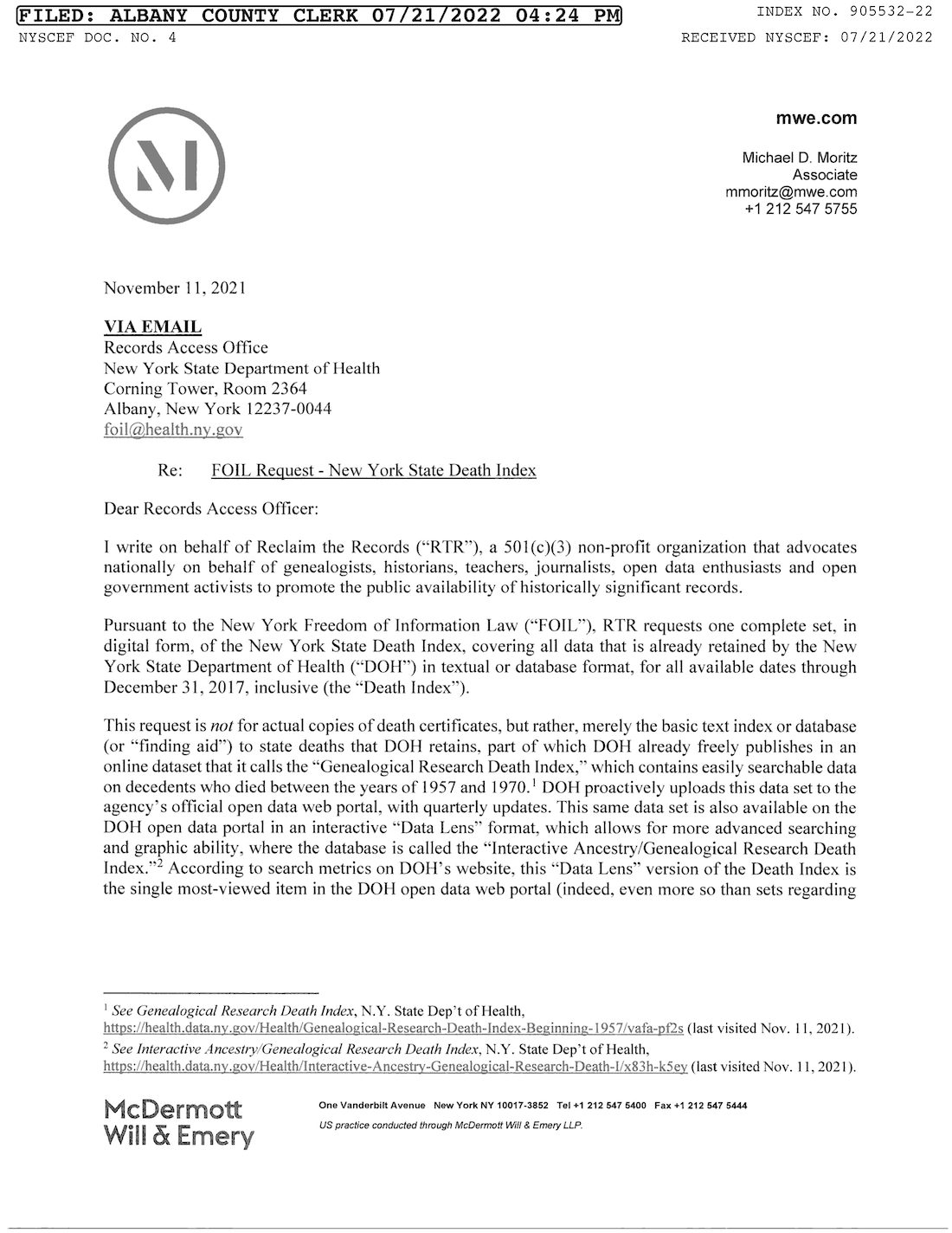
Our original FOIL request for the New York State death index
Submitted to the DOH - November 11, 2021
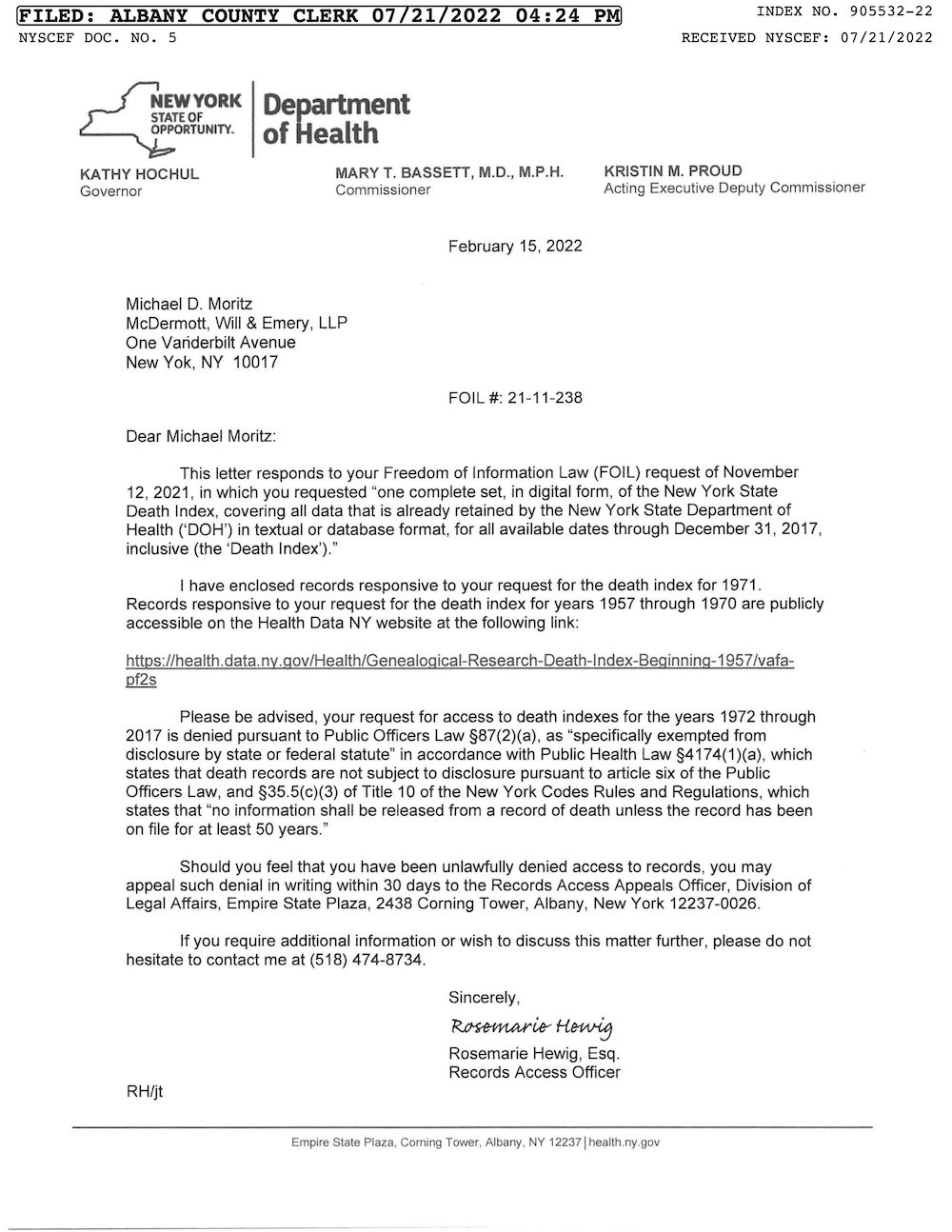
FOIL Denial from the DOH
They handed over one single year of data, for 2017, and then either ignored or rejected our request for any other data - February 15, 2022
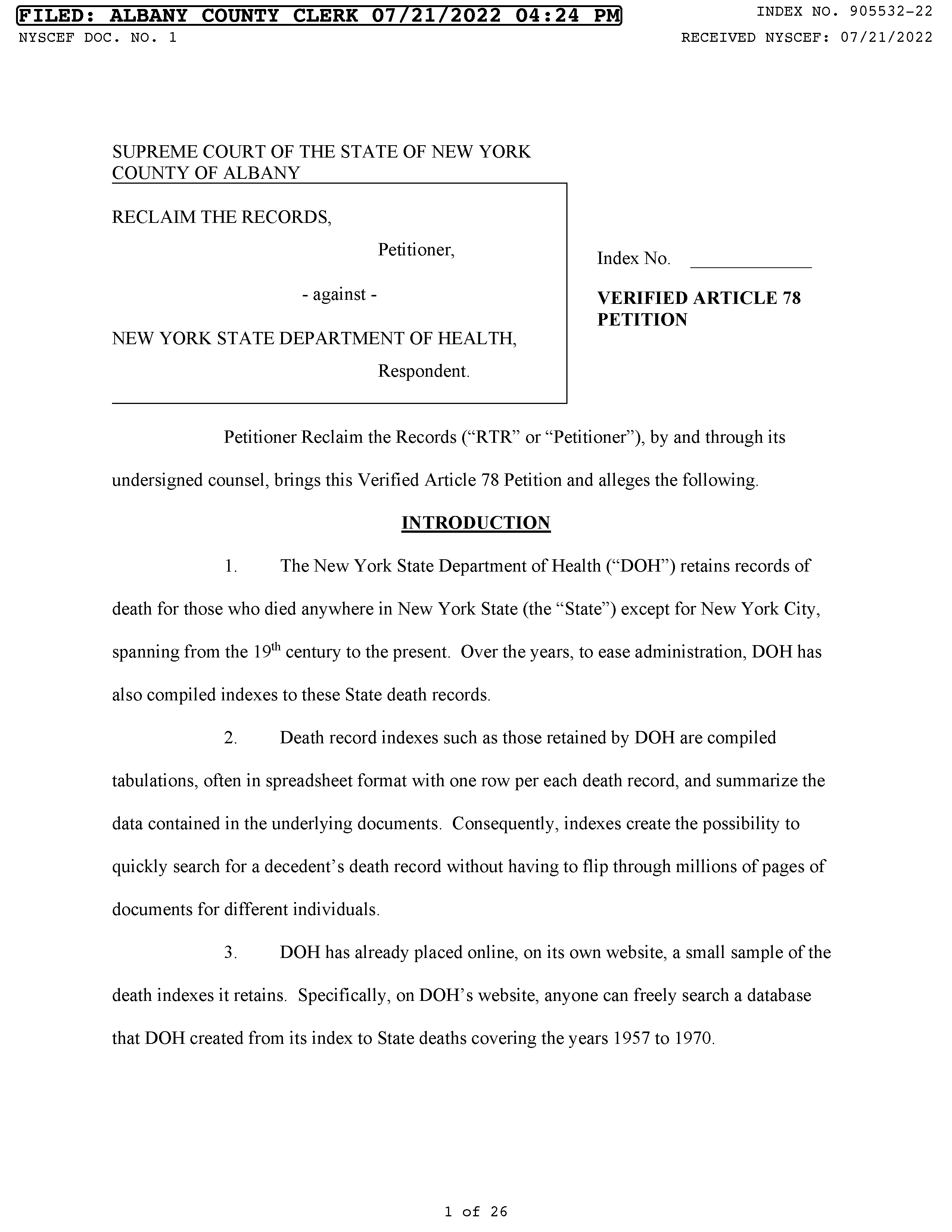
Our Freedom of Information Law (FOIL) Petition
So naturally, we sued them. We filed this "Article 78" Petition in the Albany County Supreme Court on July 21, 2022
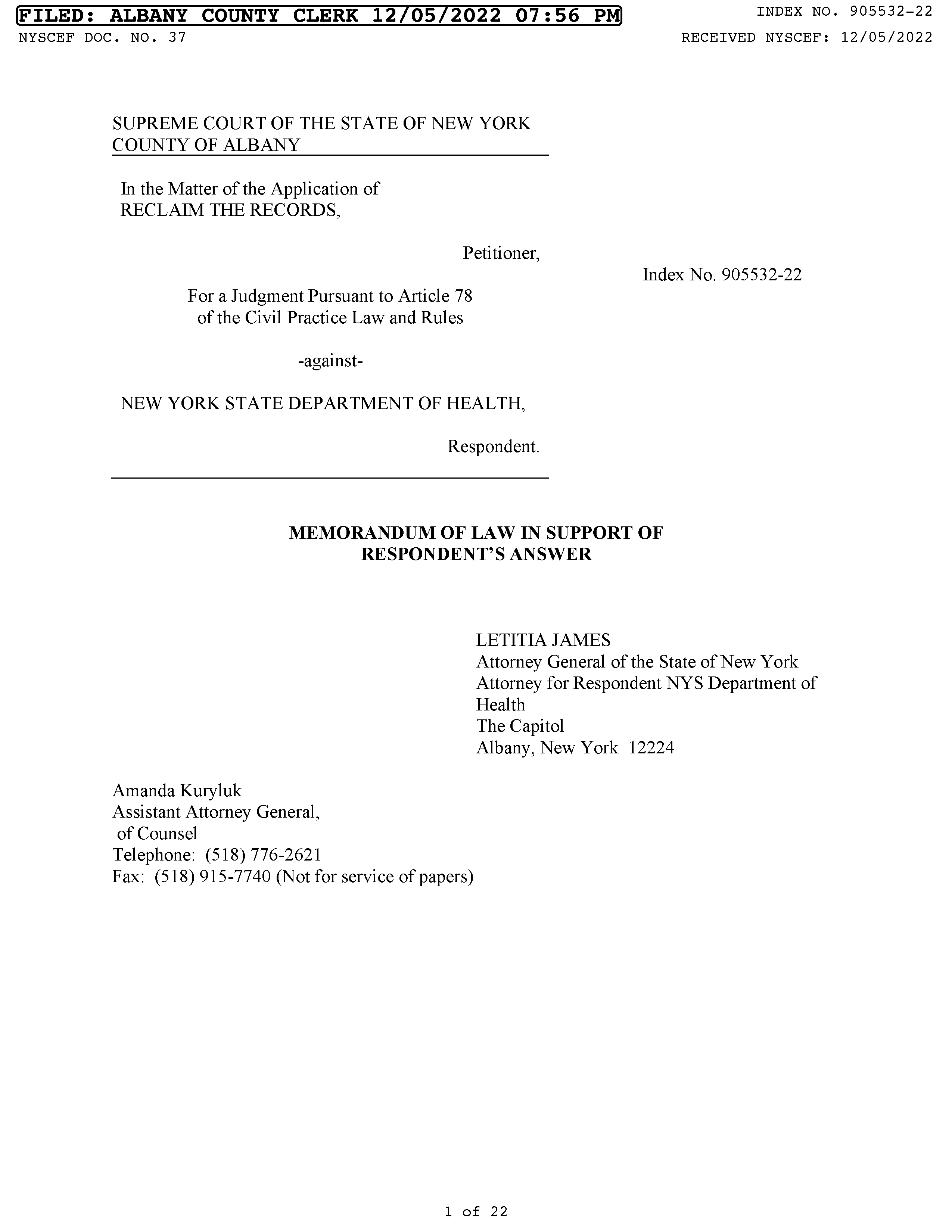
The DOH's Memorandum of Law
This is the part where the DOH explains why they think they can ignore parts of our FOIL request and just withhold public records from the public - December 5, 2022

RTR's Memorandum of Law
We fired back at the state's refusal to turn over the files, and their unsound legal justification - January 12, 2023
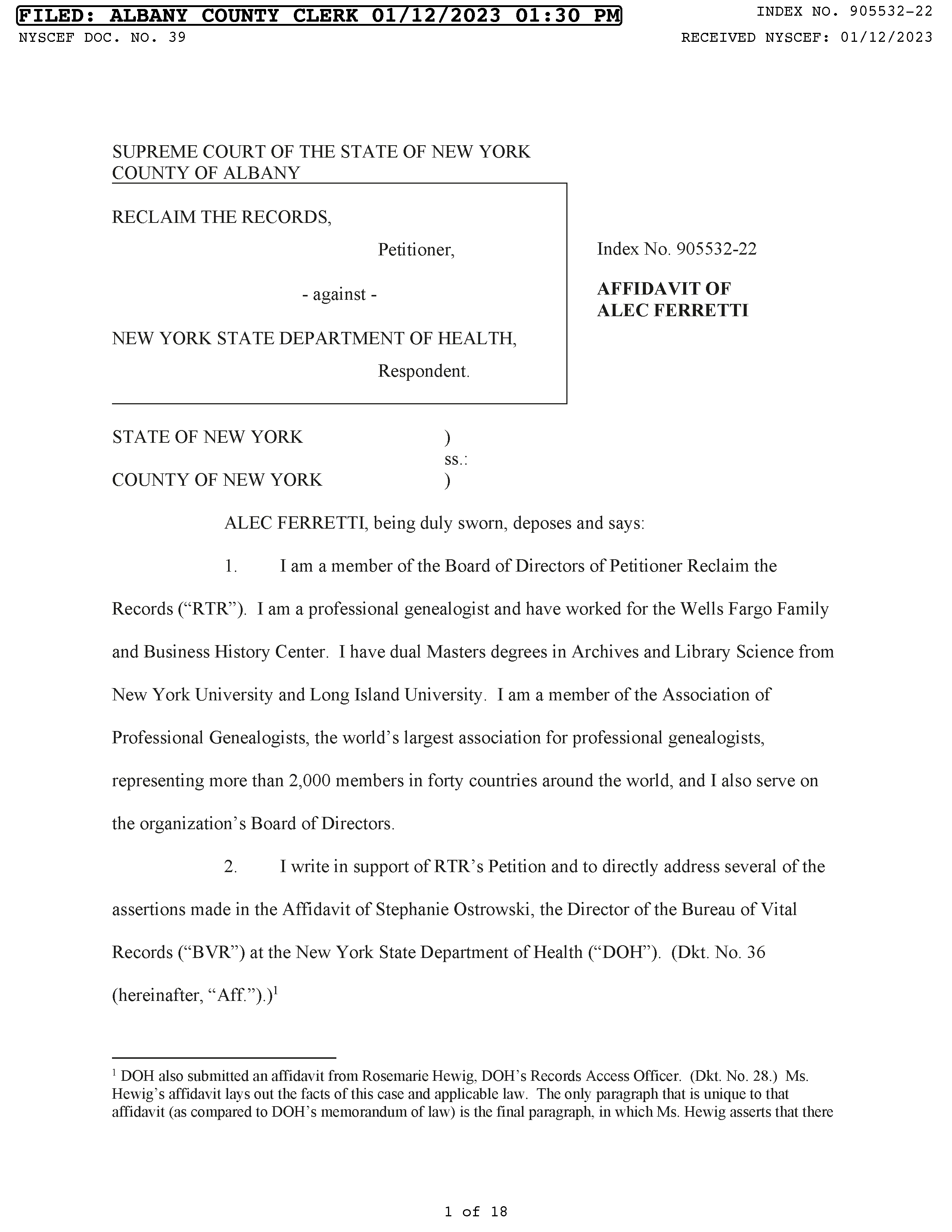
Affidavit from Alec Ferretti
Our board member (and professional genealogist) Alec Ferretti submitted an affidavit directly addressing and refuting some of the state's points
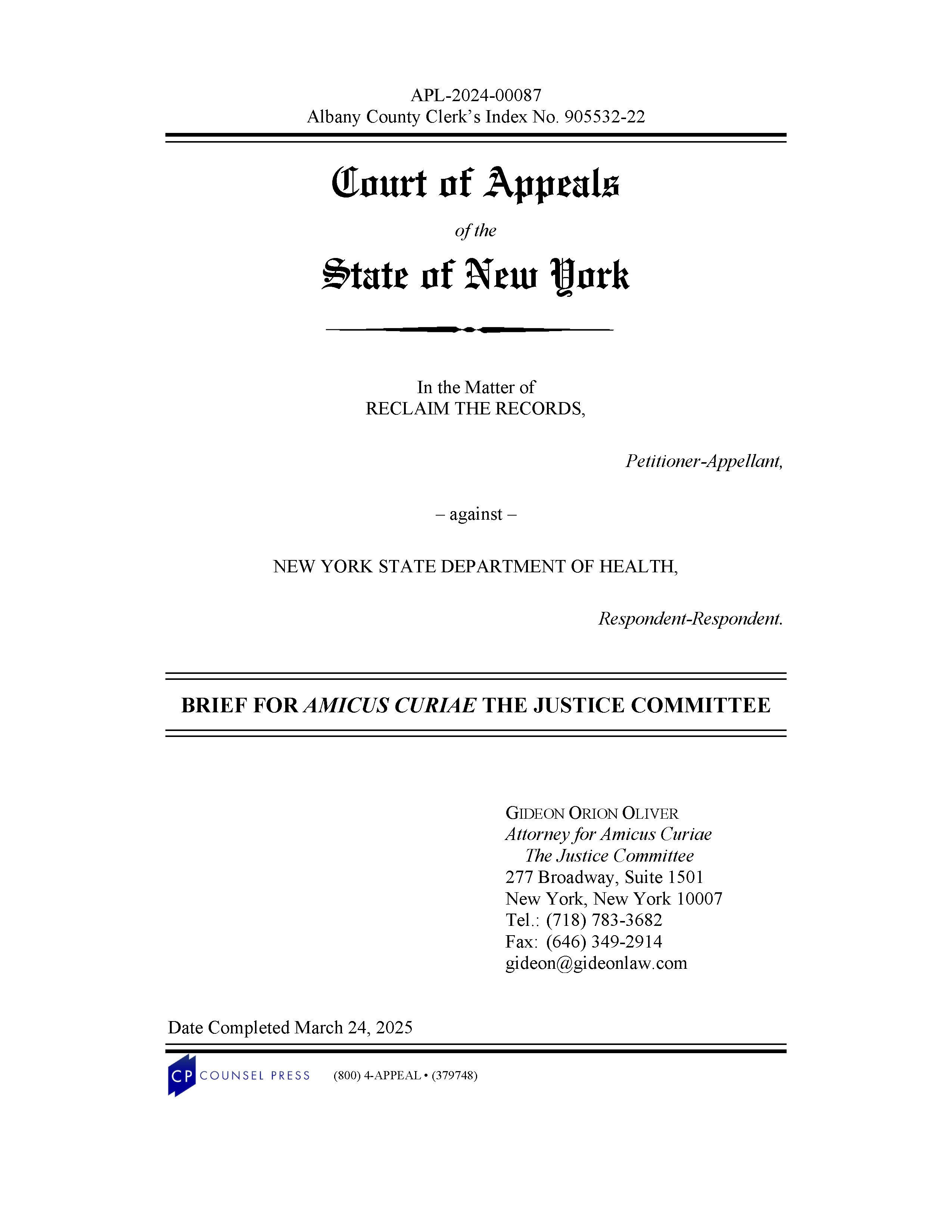
Amicus Curiae brief from the Justice Committee
Submitted to the Court of Appeals, in support of Reclaim The Records - March 24, 2025
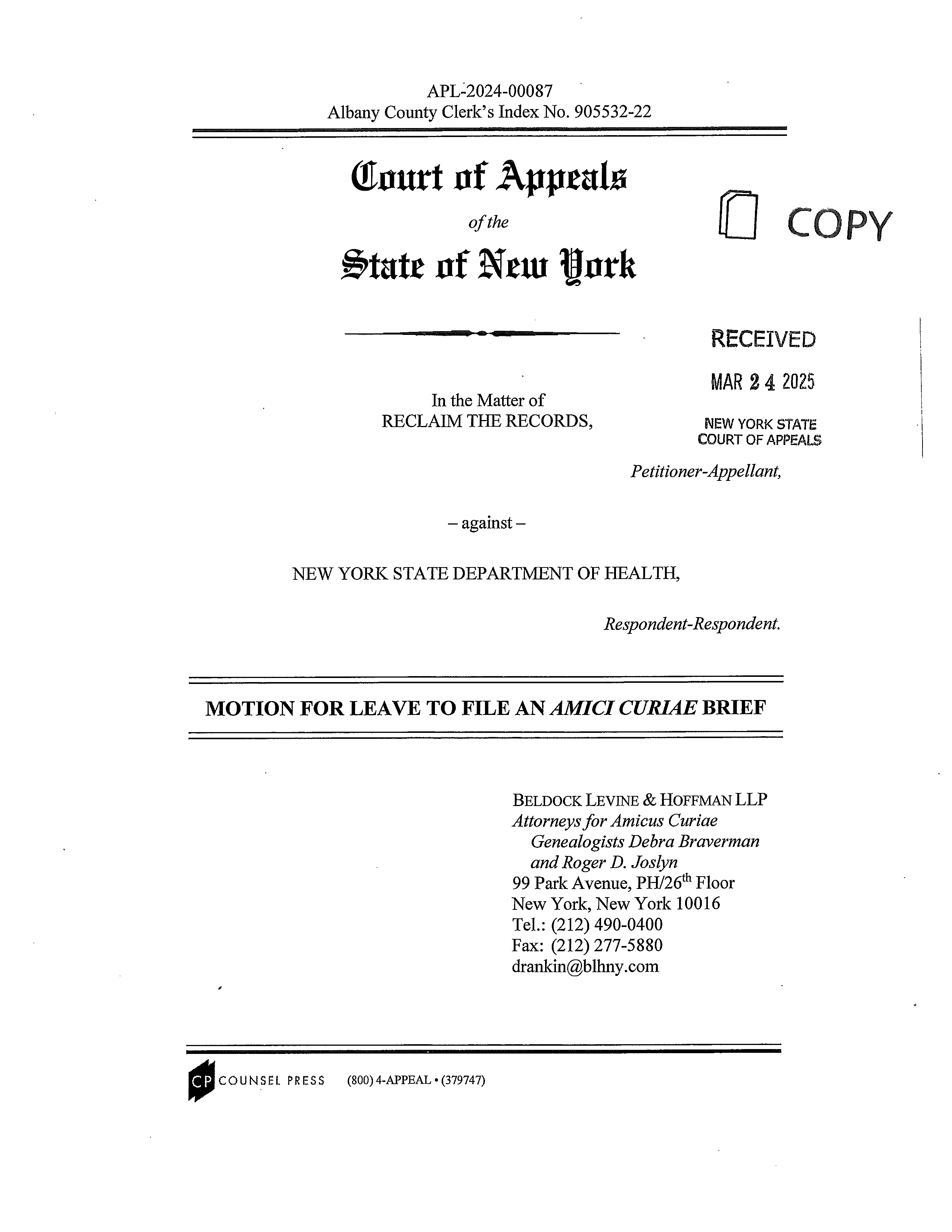
Amicus Curiae brief from two professional genealogists, Debra Braverman and Roger Joslyn
Submitted to the Court of Appeals, in support of Reclaim The Records - March 24, 2025

Decision from the Court of Appeals
After spending a few years winding its way through the courts, the New York State Court of Appeals (the highest court in the state) ruled in our favor on May 25, 2025
State or Vital Records Jurisdiction: New York City · New York State
Government Agency: New York State Department of Health
Law: New York State Freedom of Information Law (FOIL)
Record Type: Death Records
Record Years: 1880-2017
Record Format: Indices
Record Physical Format: Very likely CSV data files, possibly SQL data files for more recent years
Number of Records (Estimated): At least 10 million, possibly more, actual count still unknown

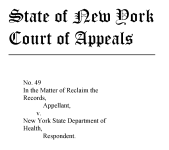 Indexed data from more than ten million records from the state of New York for the years 1880-2017 have now been ordered released by the New York Court of Appeals, the highest court in New York.
Indexed data from more than ten million records from the state of New York for the years 1880-2017 have now been ordered released by the New York Court of Appeals, the highest court in New York.